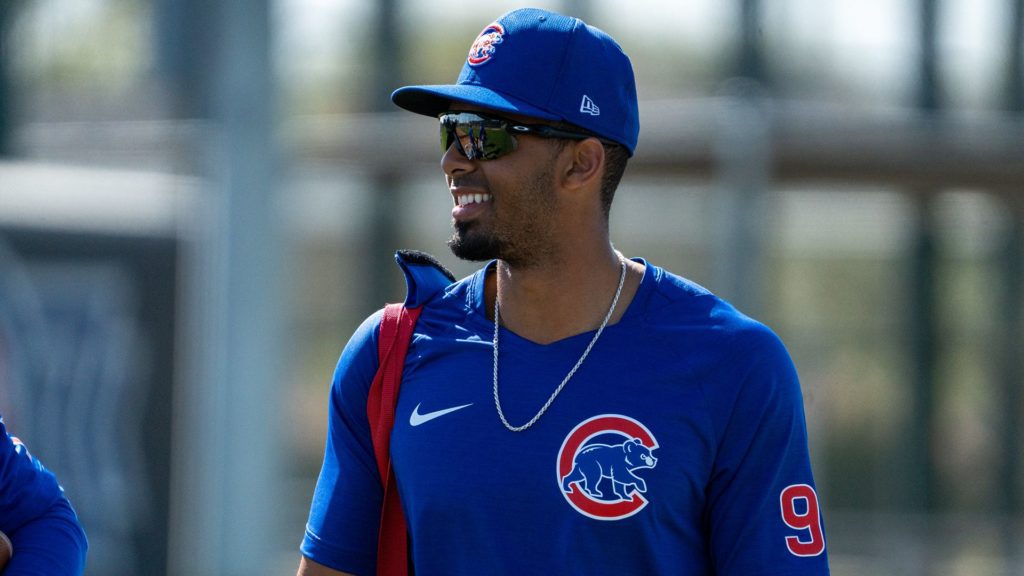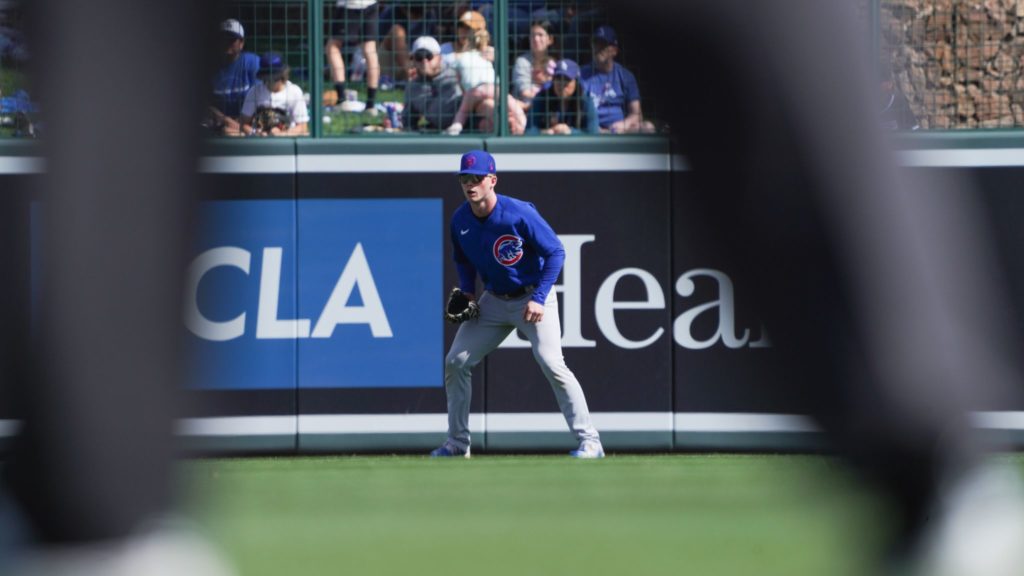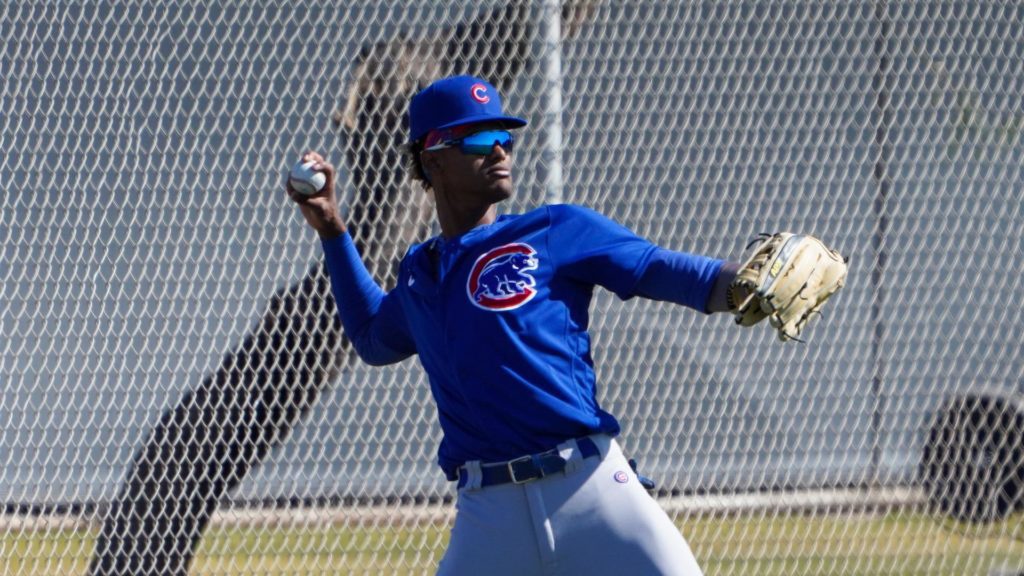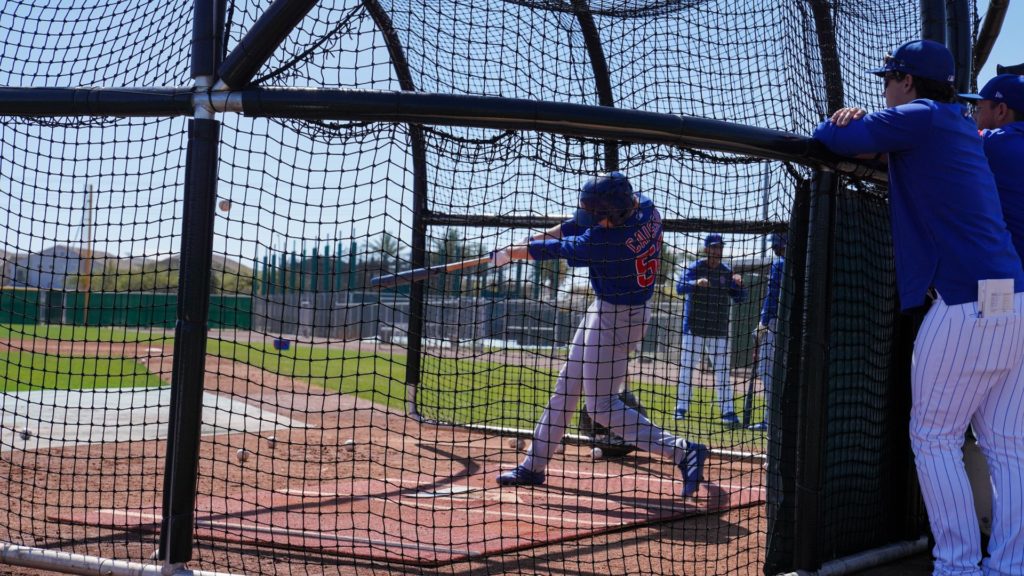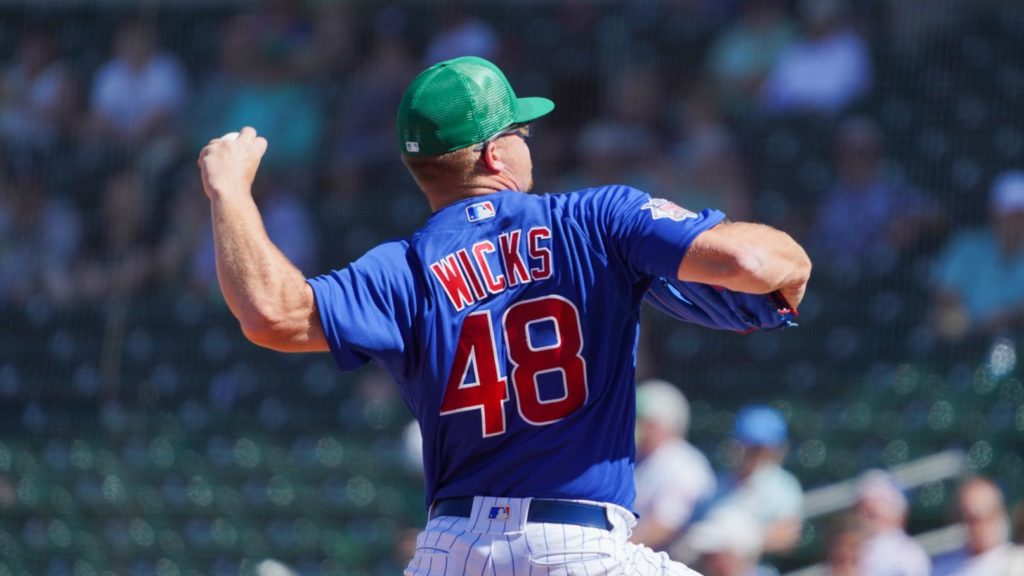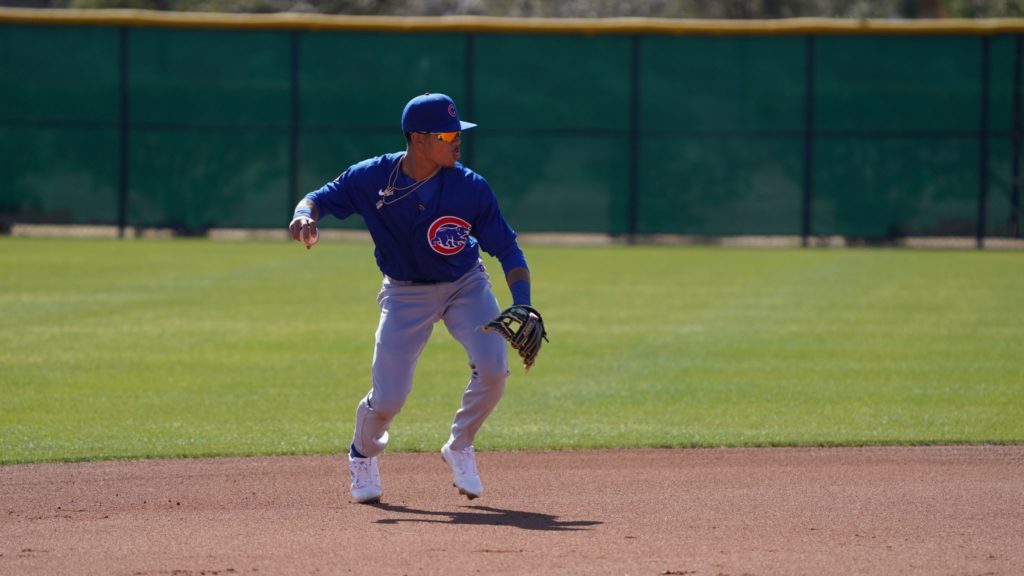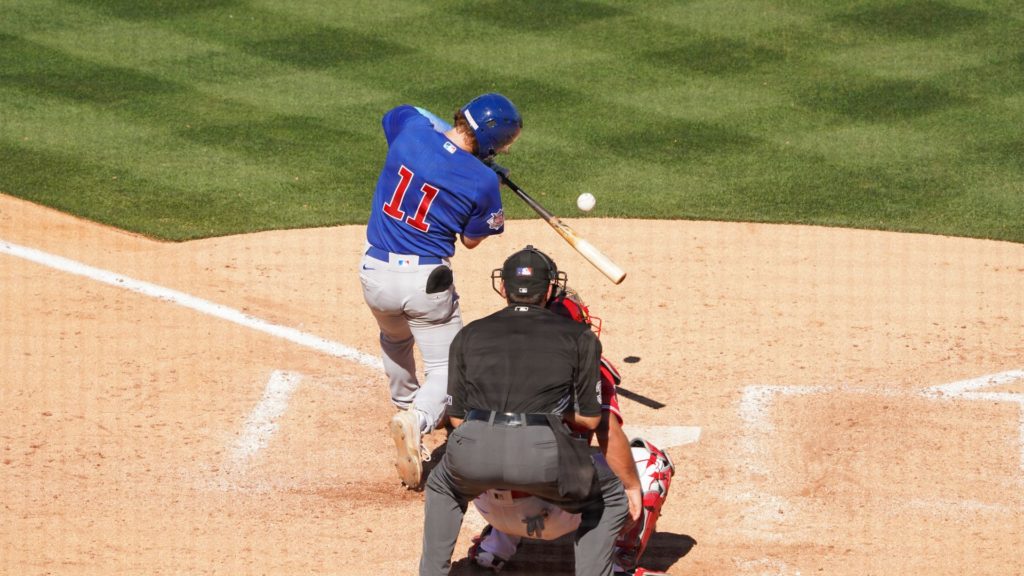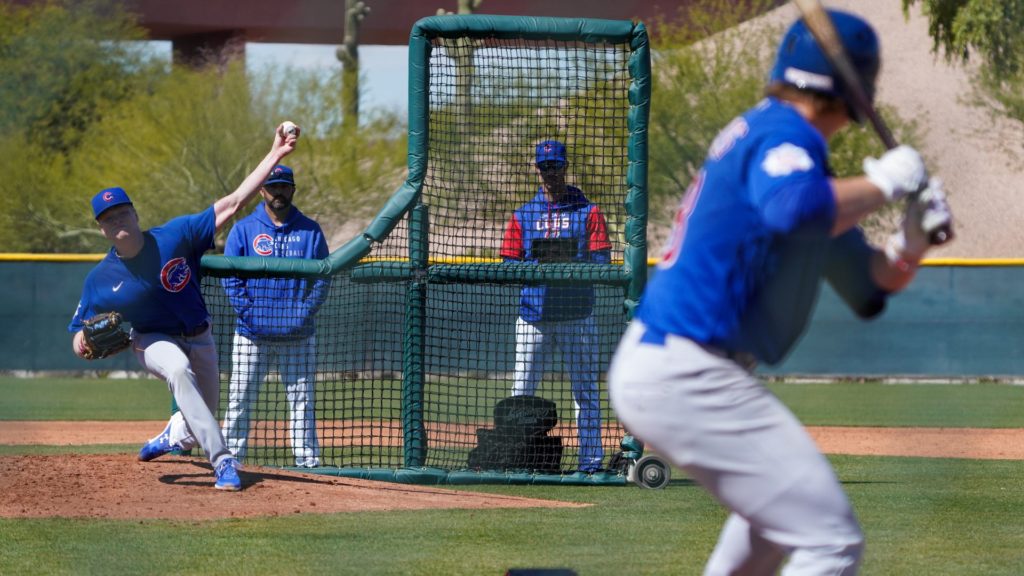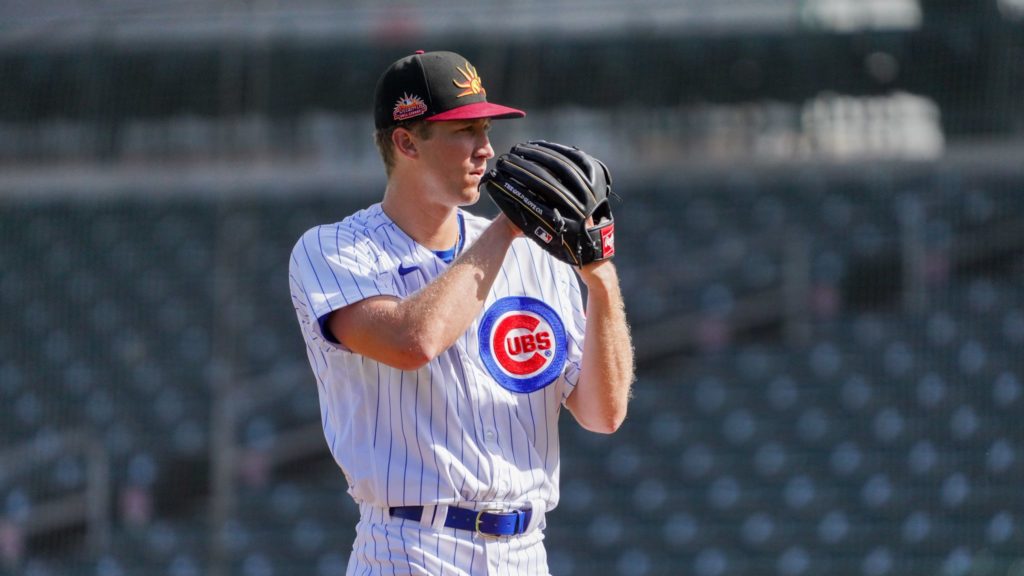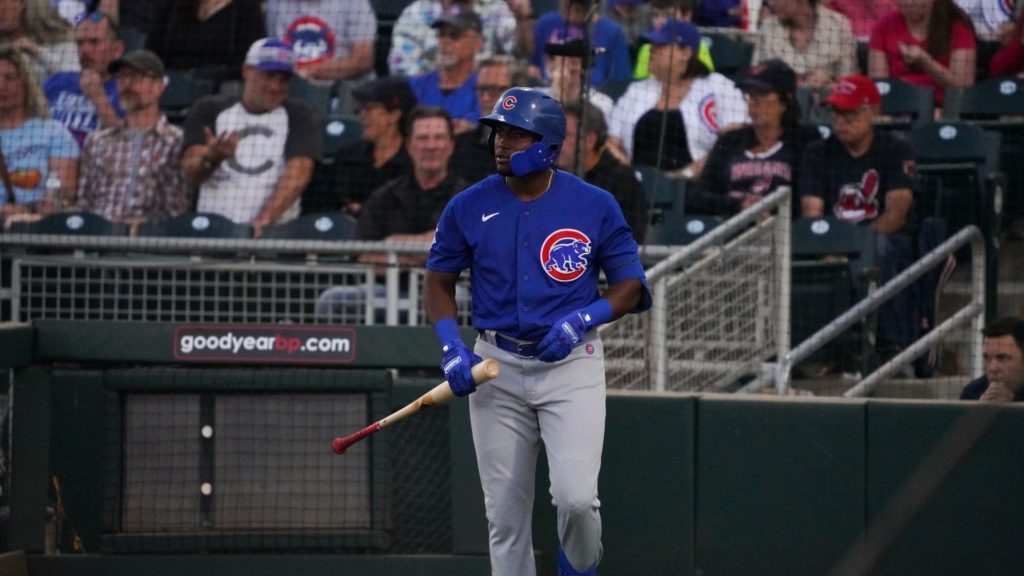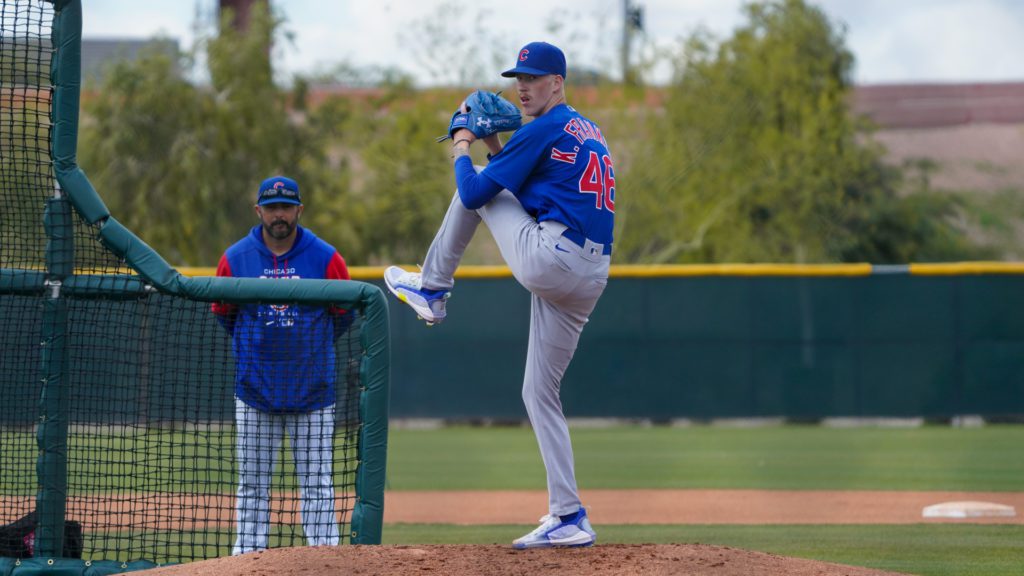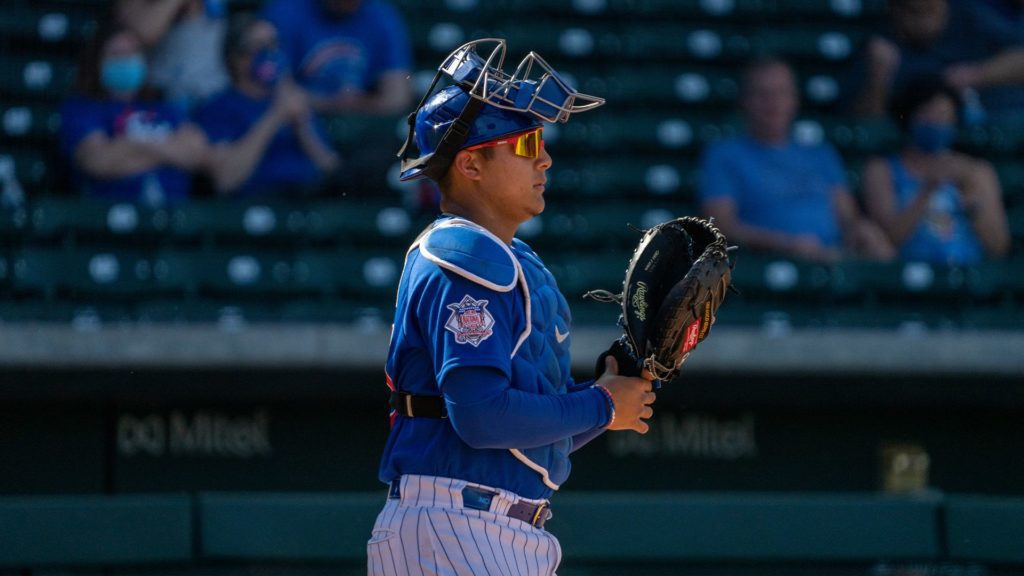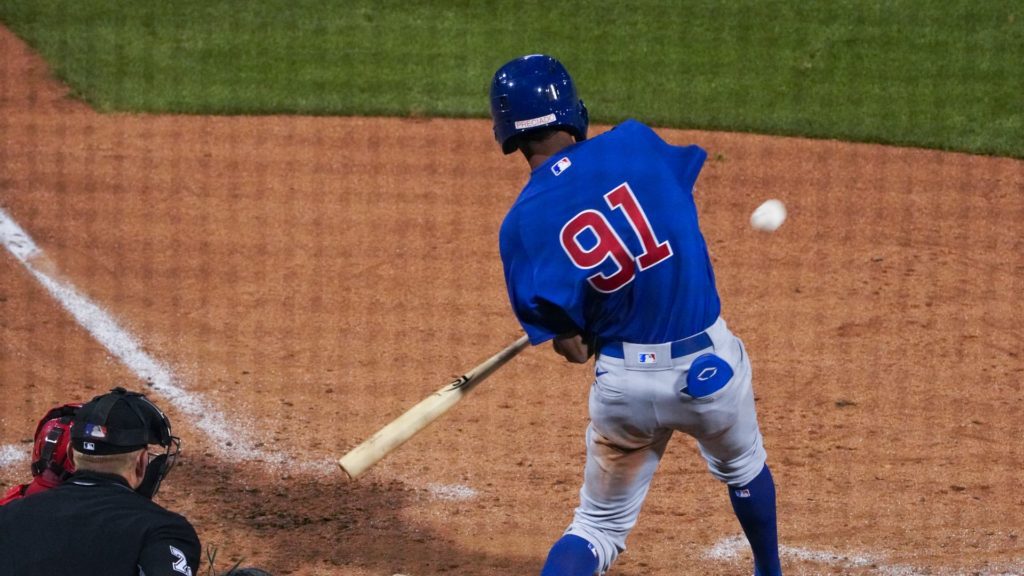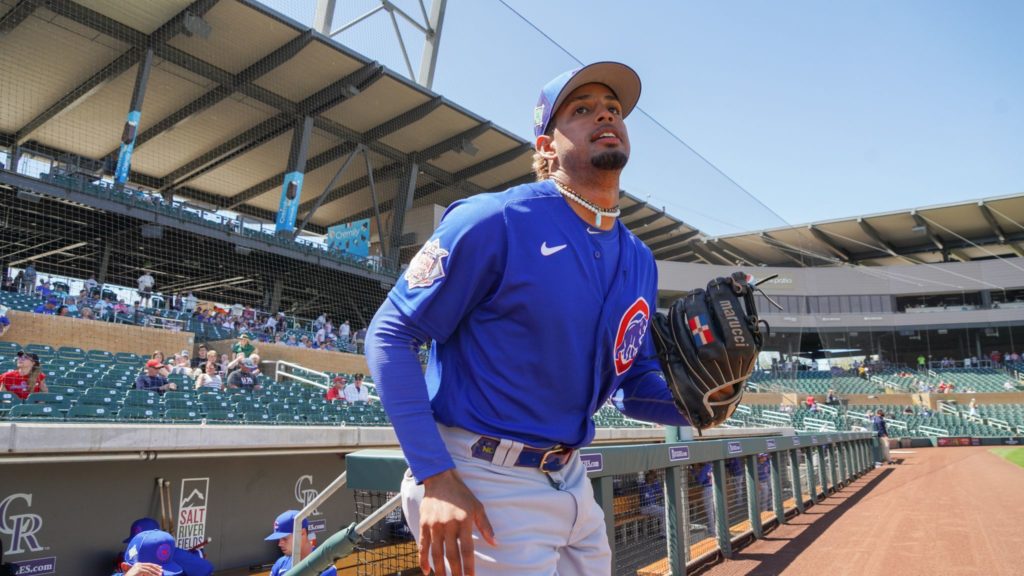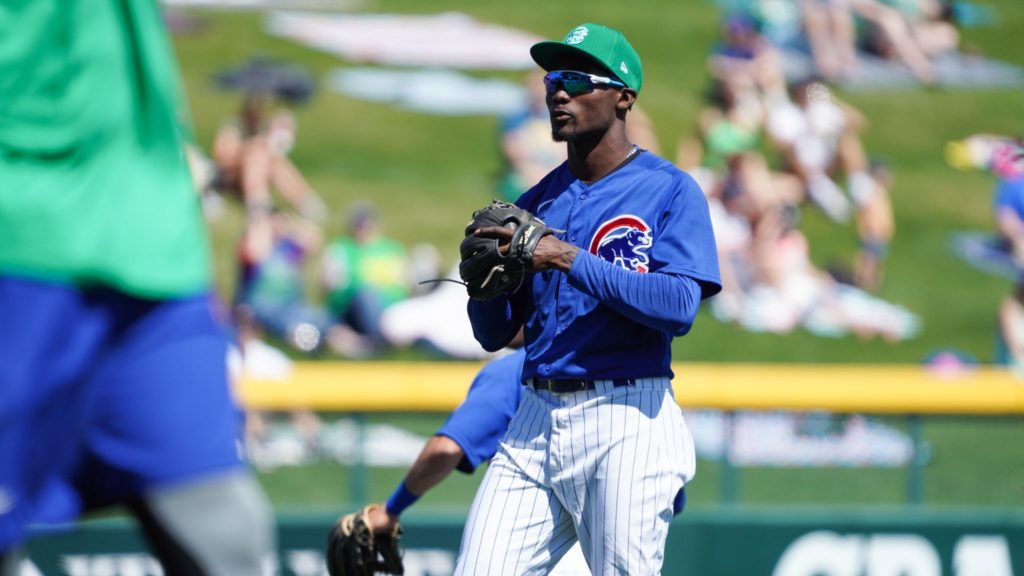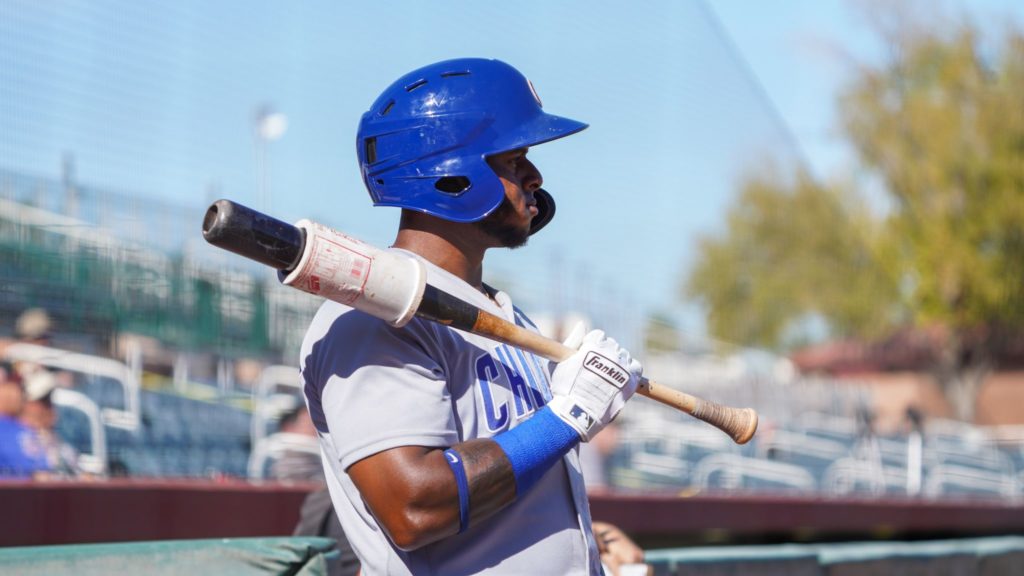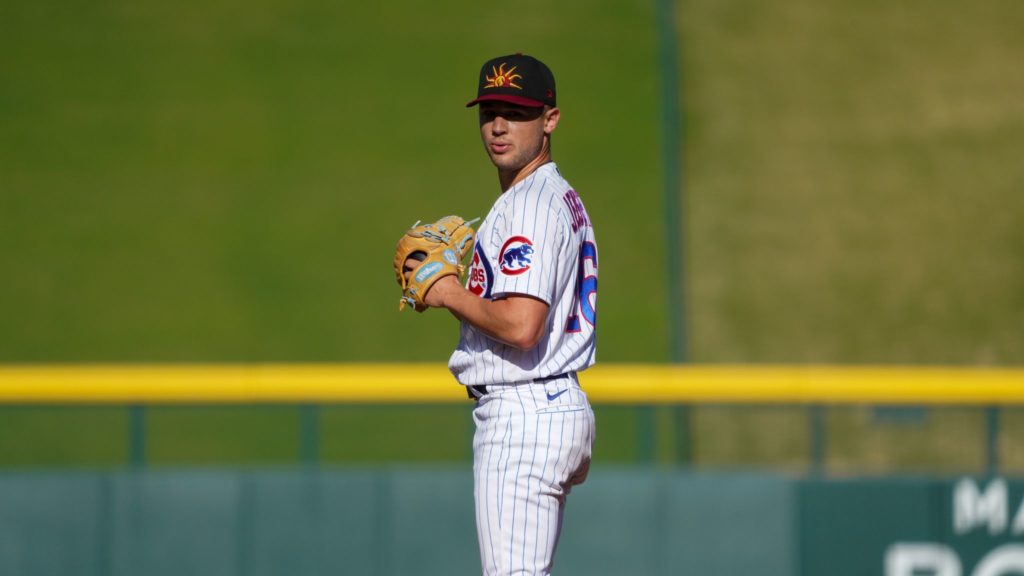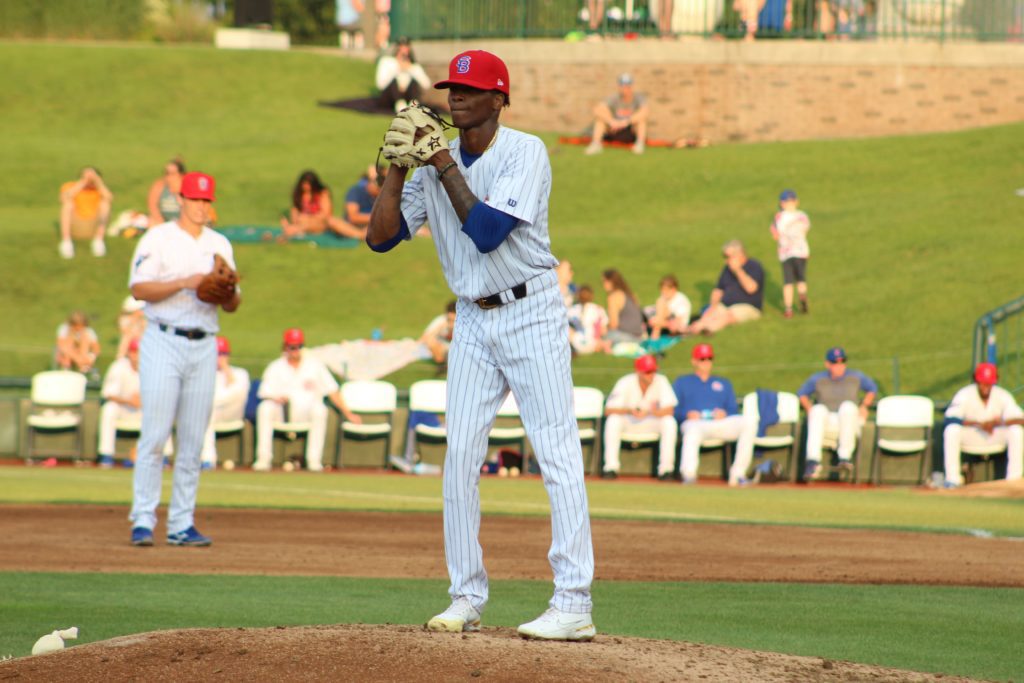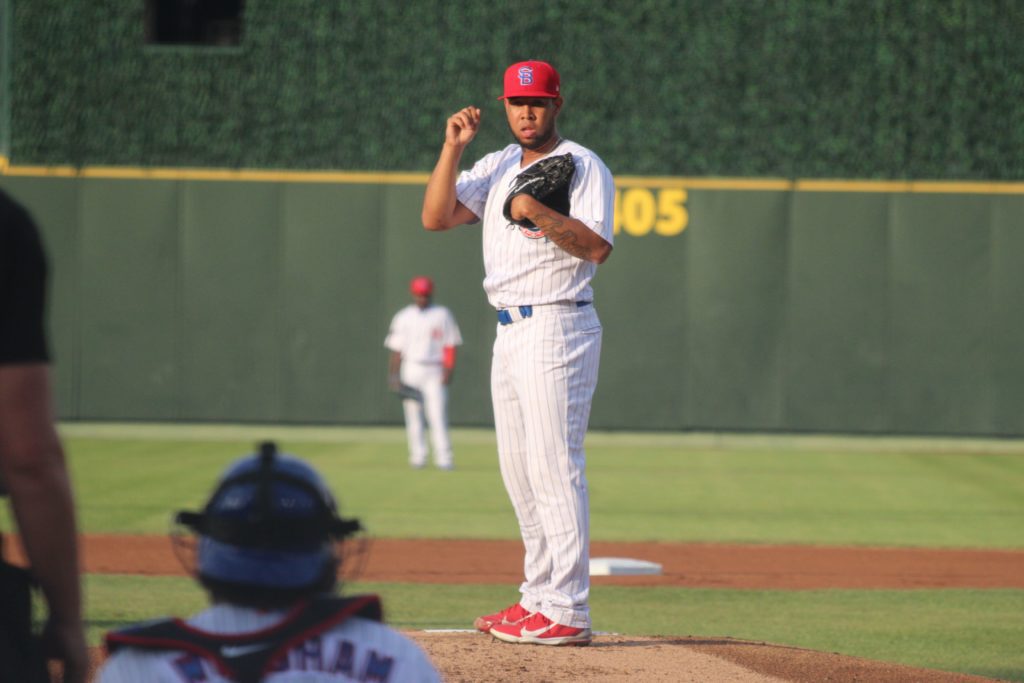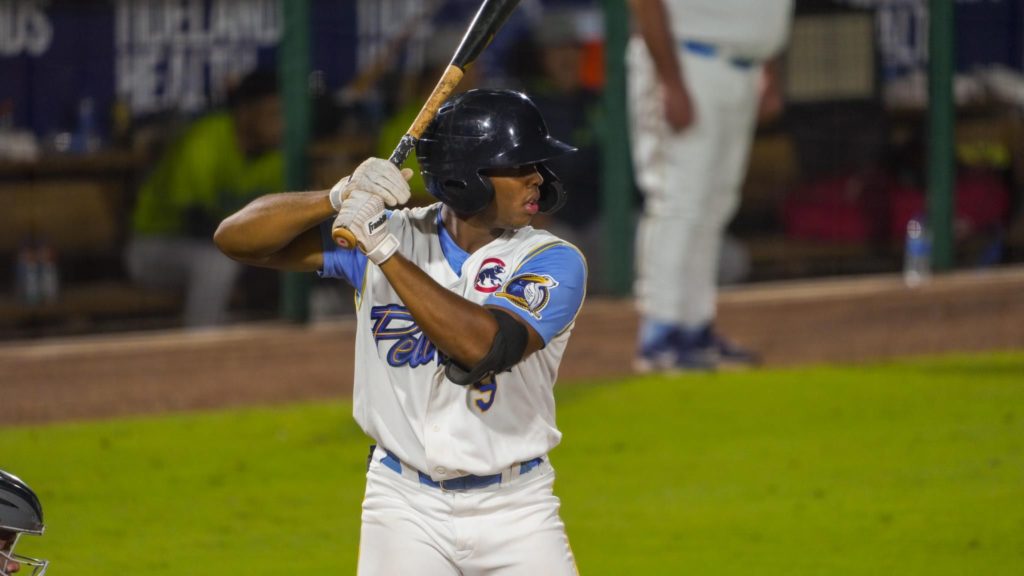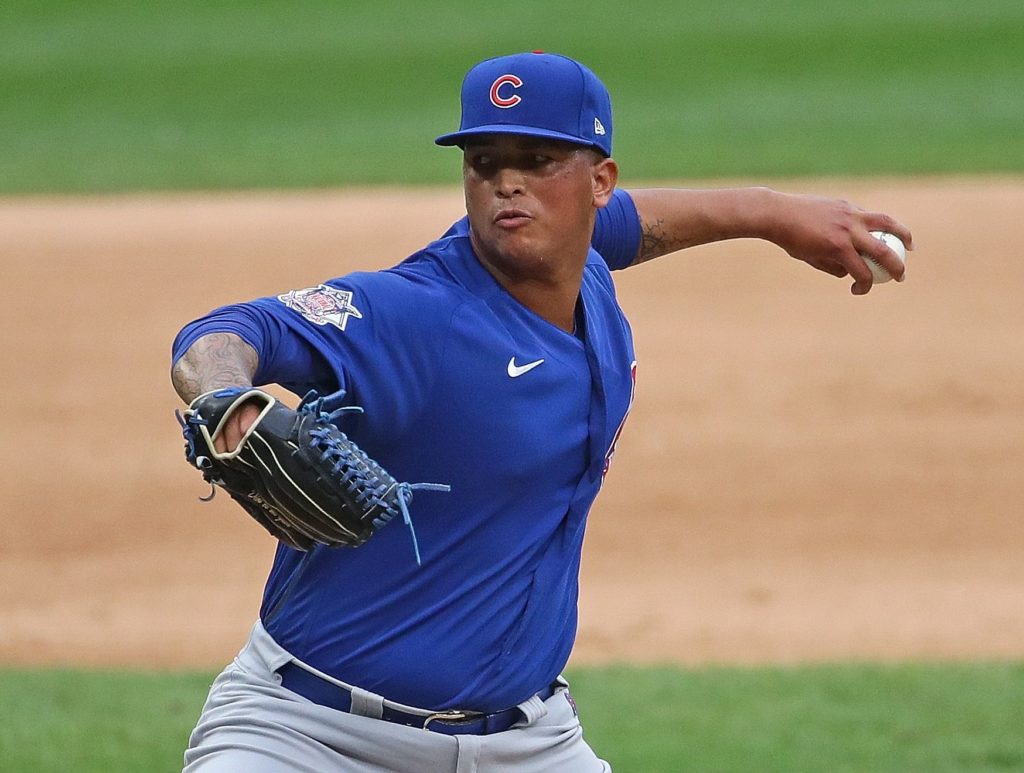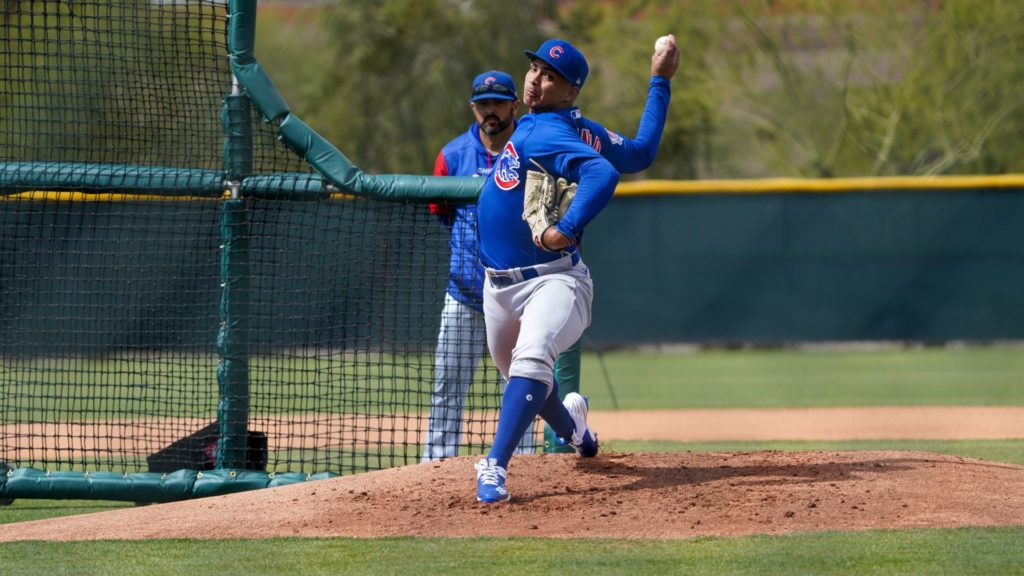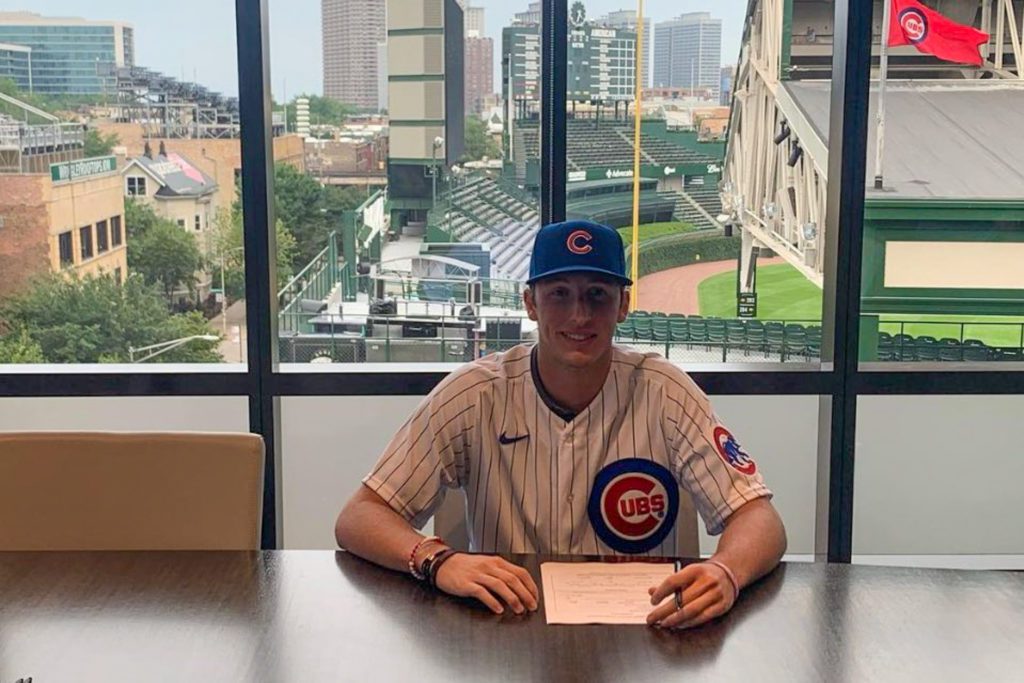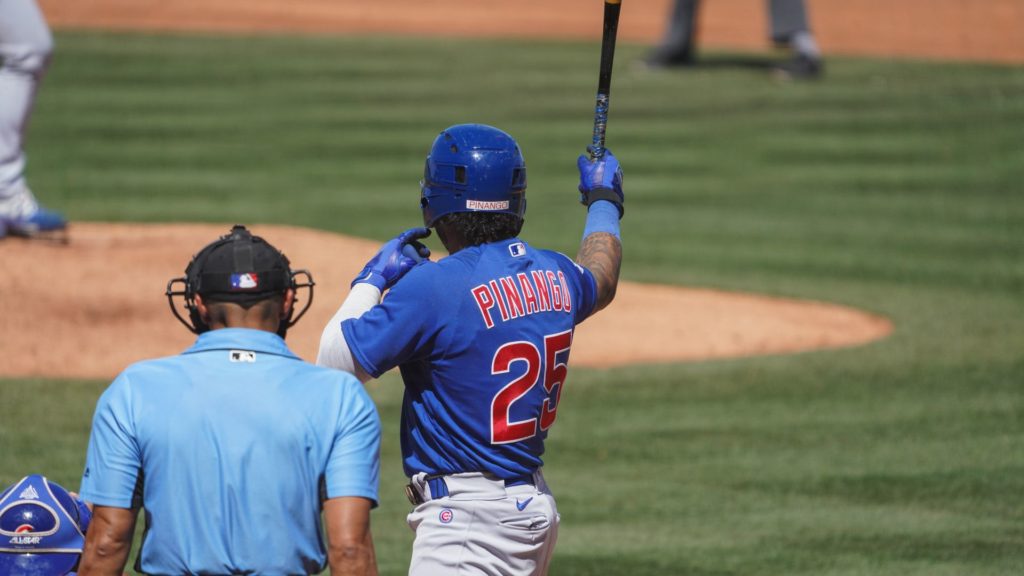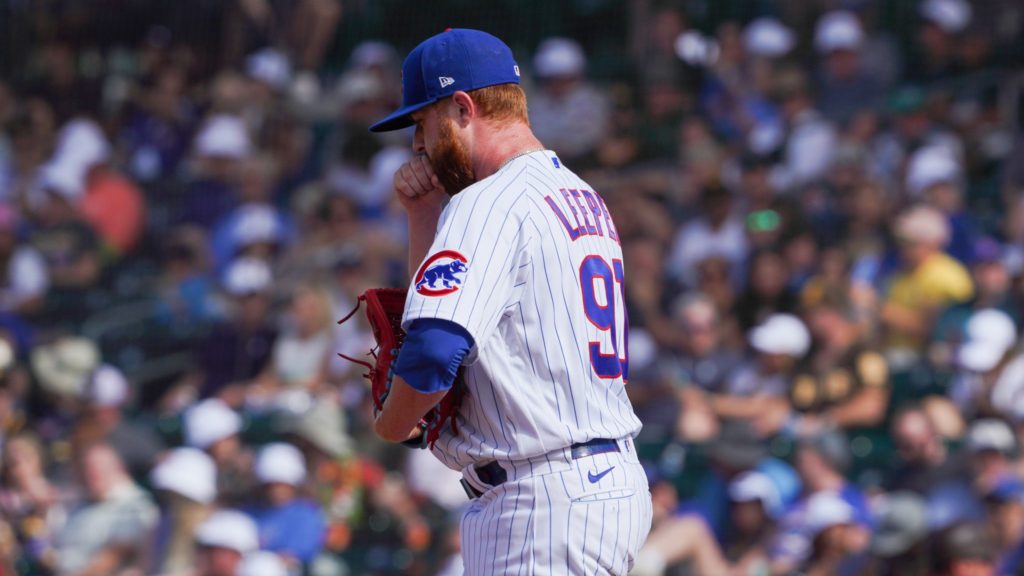Top 25 Cubs prospects: 2022 preseason
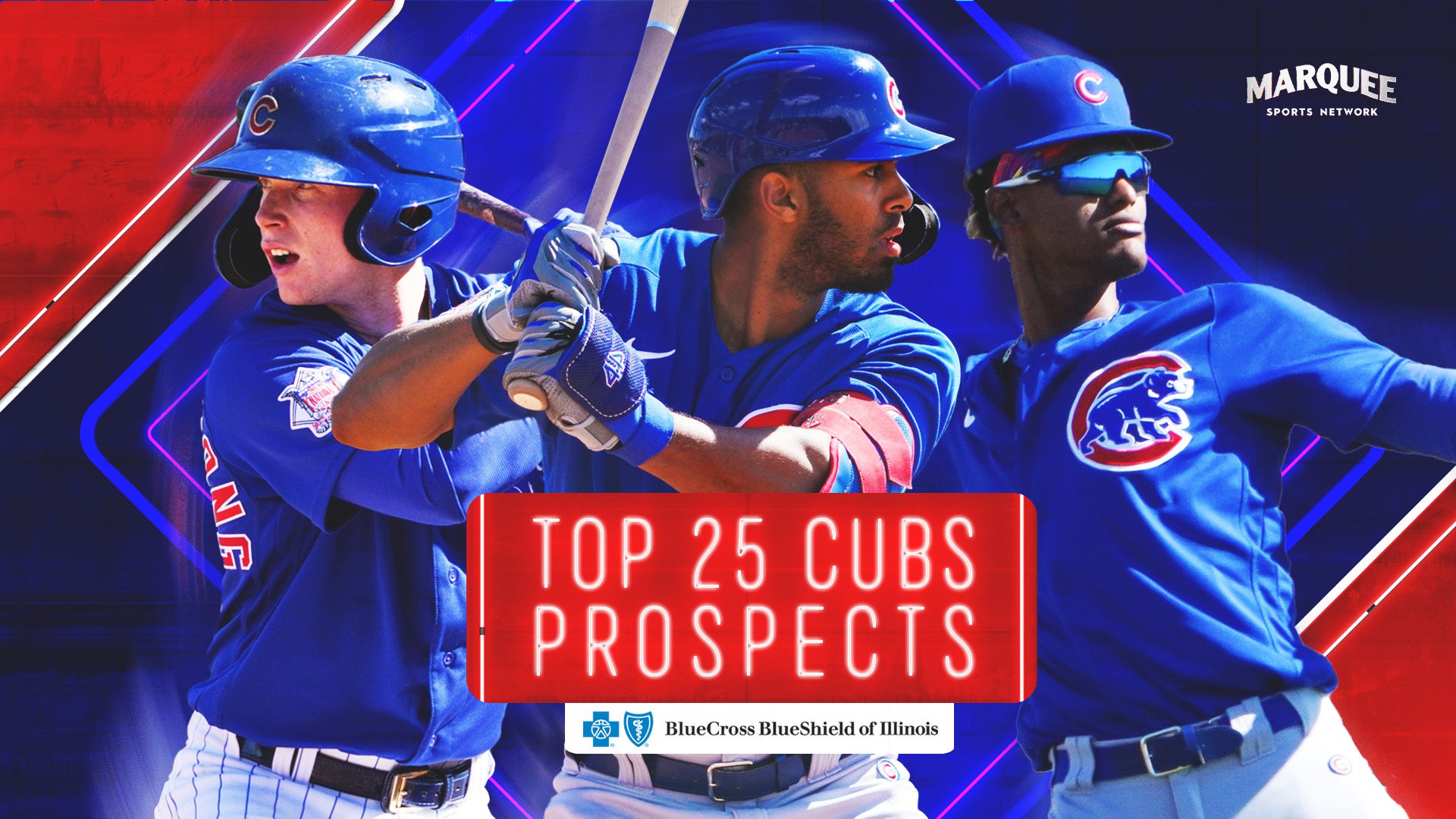
Lance Brozdowski is a player development analyst for Marquee Sports Network. Below is Lance’s list of the top 25 Cubs prospects as the Cubs begin the 2022 campaign. For more on the Cubs prospects all season long, follow Lance on twitter @lancebroz.
Another season is upon us. And still we haven’t had a normal offseason since the calendar flipped to 2020.
This time, a lockout prevented prospects on the 40-man roster — like Alexander Canario, Brailyn Marquez and Nelson Velázquez — from communicating with the organization’s coaches and staff for roughly three months.
Many non-40-man prospects, however, had the chance to participate in the Cubs’ novel offseason player development camp that included four months of housing, meals, full training staff, real-time feedback and plenty of days with two workouts — morning and night. Brennen Davis, DJ Herz, Caleb Kilian, Kevin Alcantara and Owen Caissie were among those who participated. It was all provided to the players at no cost to them.
Most other organizations have something like this for just 2-3 weeks after the season ends. The Cubs believe they are the first to engineer a program at this scale and for this period of time.
The first two months of the player development camp focused heavily on strength and conditioning — make players stronger, which would ideally lead to greater velocity on the mound or higher exit velocities at the plate.
The key to achieve this, according to the Cubs head of high performance and sports science, Cory Kennedy, was simple: measure and track over time. To consistently improve something and scale that improvement across an organization, you have to measure what you believe is valuable. For the Cubs, that’s strength (what is a player’s max strength) and power (how quickly can they reach that max strength).
The results so far, after the organization committed to change entering the 2020 season, are beyond positive. And that’s reflected in the performance of many prospects below.
Every team is trying to find an edge. Maybe it’s in pitch design or how an organization develops a particular brand of hitters. For the Cubs that differentiator may be in high performance. The ability to consistently develop explosive power and manage workloads better than other organizations could give the team an edge.
The list below very much resembles my 2021 midseason update with new blurbs to reflect new information or perspective gained via reporting, analysis and live looks from spring. We’ve expanded the rankings to 25 from 20 because there are a ton of players in the tier of prospects beyond the top talents that deserve to be recognized. Come May or June, when a decent sample of games have been played, I’ll be able to compare last season’s data for each of the player’s below with this coming season’s info and objectively point out improvements and changes in things like exit velocity for hitters and pitch shapes for hitters.
I hope you’re as excited for that as I am.
Check out past lists:
Top 20 Prospects: 2021 mid-year rankings
Top 20 Prospects: 2021 preseason
1. Brennen Davis, OF
No surprise here. Davis is the best prospect in the Cubs organization and at least a Top 30 prospect in all of baseball. His profile is one of balance. He hits the ball consistently hard, he makes a good amount of contact and his swing decisions are optimal. It’s the combination of hit, power and approach that makes him special.
Based on his minor league batted ball data, it doesn’t seem like he’ll be posting massive max or average exit velocity numbers, at least upon his initial call up, but the sample of hitters in Major League Baseball who have succeeded without astronomical batted ball metrics is long (Nolan Arenado, Charlie Blackmon and Alex Bregman come to mind). What makes those hitters great is their ability to avoid chasing pitches out of the zone and supreme knowledge of what pitches their swing can do damage on (aka, optimal swing decisions).
Perhaps the most impressive thing about Davis is a swing adjustment he progressively made towards the end of 2021 when the Cubs promoted him to Triple-A Iowa. Even after succeeding at two levels, Davis started lowering his hand placement in his pre-pitch rhythm. The central idea was to get his body into his launch position, or the moments before he begins to rotate, as quick as possible. Higher hands meant a slightly longer path into this position.
Some would ask why make an adjustment when you’re succeeding. For Davis, I think that answer ties back to a concept heard often from multiple coaches in the organization. To paraphrase, the organization’s goal is to develop great major league players, not great minor league players. Success in the minors with a particular swing doesn’t guarantee success in the majors.
The foresight for Davis to make this adjustment, mostly on his own, is impressive.
2. Pete Crow-Armstrong, OF
Scouting is such a nuanced art, built on thousands of looks at all kinds of players. For the general fan, watching a 20-year-old and predicting whether he’ll succeed is nothing more than a guess. What does major league power look like in a 19-year old? How do you determine whether a player will slow down with more weight and move off a certain position?
With that said, I don’t believe there is more visible elite skill in the organization than Crow-Armstrong’s defense. Anybody who has watched baseball before can observe his movements in the outfield and notice something is different about how much ground he covers and how smooth his actions are. Although defensive stats can vary based on the publication, there’s minimal reason to think Crow-Armstrong won’t routinely top outfield defensive value leaderboards at a premium position at the major league level. And that is the central reason he is No. 2 on this list.
The wild card is his bat. Crow-Armstrong overhauled his swing this offseason with the help of multiple Cubs coaches, which I encourage you to watch and read more about. The general idea: close off his stance and raise up his hands in order to keep him on plane with pitches longer.
Reports from backfield Spring Training games have been inconsistent, very possibly just a result of him making the adjustments in a game setting for the first time, a process that takes time. The hope is he can generate a league-average or better on-base percentage with some speed and let his advanced approach and knowledge of the zone carry his offensive profile. If this happens, he’s a mainstay in the Cubs outfield for years to come.
3. Kevin Alcantara, OF
One of the most common practices in the land of prospects is finding comparisons for people to understand what a player looks and swings like if they’ve never seen the player in the batter’s box. For Alcantara, that task is difficult. He stands 6-foot-6 and 188 pounds, a lanky player that appeared more filled out in his frame than reports had suggested when I saw him for the first time this spring in Arizona. Sure, he could add 20 pounds to fill out fully, but the more important thing is that Alcantara’s max strength continues to increase and his ability to generate that strength as quickly as possible (his power output) is a much more important goal than just adding weight.
If his strength does increase over time at the hands of the Cubs high performance staff, he’d be building on an already good batted-ball data profile. His average exit velocity is already bumping up against the major league average of 88-89 mph. But he couples that with some of the highest swing-and-miss and chase among the Cubs top prospects. The positive is that his ability to make contact, particularly in the zone, is good. This gives some confidence that a more mature understanding of the strike zone and optimized swing decisions (is a player swinging at pitches where they produce slugging percentage?) could lower his swing and miss to a tolerable level for the level of power production he will have.
Beyond his stature and projection, it’s very apparent that Alcantara is a vocal leader among his peers. He is constantly laughing and joking around with teammates, smiling and carries an aura of confidence on and around the backfields. His first taste of full-season ball will come this season and we’ll know a lot more about how his swing and size hold up against better pitching. All signs at the moment point way up.
4. Owen Caissie, OF
One way I like analyzing hitters is to look at how hard he hits the ball, how much he chases pitches out of the zone and how much he makes contact (more insight here).
Comparing Caissie to Alcantara on this spectrum provides a good contrast to different kinds of production on the offensive spectrum. While Alcantara produces high exit velocity numbers, he has a high chase rate and average-to-good contact rate. Bring his chase down and his profile soars. Caissie has similar average and max exit velocity numbers but has an odd combination of a low tendency to chase and low ability to make contact. So where Alcantara needs to lower his aggression and optimize his swing decisions, Caissie’s profile focuses on figuring out how to make more contact.
If he does that and maintains his low chase rate and average swing-and-miss, the resulting profile would give him the highest offensive upside in the Cubs system. Something near a .260 average with a .360+ OBP and 30 home runs per year would be a high-probability outcome and desired by a Cubs system that tends to have more hit- and contact-oriented players than big raw power.
Caissie’s speed and defense are both slightly below average at the moment, which will probably keep him in left field or eventually move him to DH depending on the Cubs future roster construction. His bat looked great this spring against much older pitching and he’ll be challenged this year at High-A South Bend. Expect Caissie to rise to the occasion.
Watch: Owen Caissie breaks down his swing
5. Jordan Wicks, LHP
2021 repertoire in order of usage: Four-seam, changeup, sinker, slider, curveball
Wicks soared through the Cubs intake procedures after being drafted 21st overall out of Kansas State in the 2021 First-Year Player Draft. He started 4 games in High-A South Bend by the middle of September, facing 14 batters in his final start of the season.
This offseason, he underwent a repertoire overhaul. For now, it seems like he’ll rely solely on a four-seam fastball, scraping his sinker for the much better of his two fastballs. His slider and curveball have both been reshaped to resemble more traditional offerings, whereas last season his slider moved more like a cutter and his curveball moved more like a slider. His changeup remains his best offering by a wide margin on the amount of swing and miss he is able to generate.
Historically, the changeups that have performed at an elite level against major league hitters are about 10 mph slower than a pitcher’s fastball and drop about 10 inches more than a pitcher’s fastball (read more here). Wicks bumps right up against these parameters, with his changeup separating from his fastball by 10 mph and 9 inches of drop. The pitch can get major league hitters out right now. If his offseason changes result in improvements to both his breaking balls, his repertoire creates the highest floor in the system. Then, velocity becomes the separator, as his 92-mph fastball would rely heavily on command to be effective in the majors.
Wicks will start the year back in High-A South Bend, with a strong chance of a call-up to Double-A Tennessee by the middle of 2022.
Watch: Jordan Wicks breaks down his pitch grips
6. Cristian Hernandez, SS
After a long time waiting to see the Cubs’ $3 million investment from the Dominican Republic on American soil, the backfields this spring provided ample opportunity for reps and swings. While his frame is relatively unassuming at 6-foot-2, 175 pounds, his actions in all facets of the game are smooth. It’s visually apparent, even from non-game action, why he demanded such a high price tag in the international market.
The batted-ball data from his 47-game sample in the Dominican Summer League (DSL) is fantastic. Sticking to our spectrum of exit velocity, chase and contact to analyze a hitter, Hernandez has a very distinct combination for a player of his age. His exit velocities aren’t massive, but when you consider he doesn’t turn 19 until December 2022, it makes one dream about above average raw power with added muscle. Especially at the hands of the Cubs high performance staff.
But perhaps the most impressive part of this profile is his combination of extremely low chase and high contact. While it was against the raw arms in the DSL, the underlying metrics in his production suggest he’ll continue to perform well in the Arizona Complex League this summer. We will know a lot more about Hernandez by the middle of the season. For now, this is an understandably conservative rank.
7. James Triantos, 2B/SS
Triantos slugged an unconscious .783 in September of last season with a 1.199 OPS. He swung early and often in counts, with around 85% of his at-bats ending in contact. He’ll see better pitching at Class-A Myrtle Beach, as the Arizona Complex League arm quality was historically poor the last two seasons. But his bat-to-ball skills probably still won’t be challenged.
Hernandez sticks out because of his ability to hit the ball consistently hard for his age, coupled with low chase and high contact. Triantos has a nearly identical mix of low chase and high contact, but his exit velocity numbers show a contrast between how consistently hard he hits the ball and the max amount of juice he can put into a given swing. If Triantos and the Cubs can figure out how to increase his raw power without making a drastic swing adjustment, he becomes a sure-fire Top 100 prospect in MLB. But there’s also reason to believe that sitting in a high tier of average exit velocity without a high ceiling could lead to exceptional production.
Where he will end up defensively changes the bar his offensive profile must meet to be an everyday, major league player. If he eventually moves to third, where he took a decent amount of reps this spring, the bar rises. If the Cubs see him at second base long term, he fits in the modern sense of how championship teams view the position, which is to prefer an elite bat in the role (think Ozzie Albies, Chris Taylor or José Altuve).
Watch: James Triantos talks through his swing and approach
8. D.J. Herz, LHP
2021 repertoire in order of usage: Four-seam, changeup, curveball
Herz’s average velocity sat around 90 mph out of high school. Last season, he sat around 92 mph and struck out 40% of the batters he faced at both Class-A Myrtle Beach and High-A South Bend. His goal this year is to sit 94-95 mph. If he is successful in his goal, the probability of him becoming the top pitching prospect in this system increases beyond that of Jordan Wicks’.
Herz’s ability to generate an above average amount of vertical movement, often called “carry” or “ride,” on his fastball despite throwing from a relatively low slot is another differentiator in his profile. Generating more carry becomes difficult as a pitcher’s arm slot lowers due to how difficult it is to apply true backspin to a baseball from a sidearm position. This is why most sidearmers throw sinkers and pitchers with big, over-the-top deliveries throw big-carry four-seam fastballs with good vertical movement. When a pitcher, like Herz, can get some added carry despite his low release, it creates a very flat approach angle for the pitch at the top of the zone. Unless a hitter has a flat swing (like Triantos or Frank Schwindel), matching the slope of a pitch with a flat approach angle becomes difficult.
This is essentially a fancy nerd way to say that Herz does something different. It shows up in the data and it shows up in the results.
His changeup is funky and fits in the elite category of changeups that drop more than 10 inches more and is 10 mph slower than the pitcher’s fastball. His curveball’s shape is in between a slider and curveball based on its movement profile. This isn’t a bad thing, especially given the pitch possessed the highest swing-and-miss rate in his repertoire, but it creates an interesting situation where the possibility of two breaking balls could be created from one pitch to stymie hitters at higher levels. Or Herz could align himself with modern thinking and lean more towards a slider shape, generating a pitch that sweeps a bit more across the zone at a higher velocity.
Even with the inherent risk of high school starting pitchers, there’s a chance Herz is a Top 5 prospect in this organization by June. South Bend should be a cakewalk for him early this year.
Watch: DJ Herz talks about his offseason
Read: DJ Herz walks through his grips and cues
9. Caleb Kilian, RHP
2021 repertoire in order of usage: Sinker, Cutter, Curveball, Four-Seam, Changeup
Kilian and Herz are very different pitchers. Where Herz succeeds with deception and raw stuff, Kilian succeeds by absolutely pounding the strike zone with multiple average to above average pitches.
You’ll often hear the saying, “velocity doesn’t matter if you can command the baseball,” citing pitchers like Alec Mills, Kyle Hendricks and Wade Miley. Which is true, but the oversight in that statement is just how good your command has to be to survive with an 88-92 mph fastball in the modern game. As we’ve seen from Inside Edge, a pitcher throwing in that velocity window on average hits his target around 70% of the time, about 20% greater than a pitcher throwing greater than 95 mph on average. And it’s also worth pointing out how much more organizations know about developing velocity than they do about developing command.
Kilian is a great mix of average to high velocity and exceptional command, but his raw “stuff,” how much his pitches move and how unexpected that movement is based on delivery and release is moreso average. The positive is that he has a lot of pitches — five of them. And his offseason focus was on his least-used pitch: his changeup. His primary weapons are a sinker and cutter, yet his four-seam fastball actually generated the most chase and swing-and-miss last year despite average shape characteristics, again because he spots the ball in the zone so well.
You can stare at data endlessly and nitpick players — I’m guilty of that a lot — but at some point, the results jump out ahead of what’s happening behind the scenes. And as we’ve come to realize in the analytics space, a lot of the time that has to do with the industry not being able to measure or fully understand something about a pitcher’s profile. I think that might be the case with Kilian. Perhaps there’s something to having command this strong that will allow him to succeed even if he doesn’t end up on Pitching Ninja every time he starts. Or perhaps he’s a case where having so many pitches that are average to above average messes with a hitters approach so much, it allows his stuff to play up. Whatever the case, his performance is undeniable and there’s a chance we’ll see him at Wrigley Field this year.
10. Alexander Canario, OF
Canario begins what I would consider the dividing line between the top tier of prospects in the Cubs organization and the players just below that tier. The way to interpret that statement is to consider that the difference between Kilian and Canario, to me, is a larger gap than the difference between Canario and my No. 14 prospect, Christopher Morel. The gap between each individual rank on this list and any list, is not the same.
With that said, Canario draws relatively even with the next two prospects that follow him, despite their wildly different trajectories. Canario’s raw power is legitimate, sitting right near Caissie as some of the biggest in the Cubs system. The advantage he has over other big-power prospects is that despite a big strikeout rate, his underlying swing and miss isn’t astronomically high. This suggests he has trouble when he falls behind in counts, like most hitters, but doesn’t struggle to make contact on pitches he should do damage on. The chances he ever produces a major league strikeout rate below 20-25% is still small, but I don’t think he’s in as much danger of posting strikeout rates in the mid 30%s as others may perceive.
The hope with Canario is that he lives around the .240 average mark, can produce a consistent 25-plus home runs and stays a corner outfielder with average speed. Down the road, he has the potential to DH depending on how the Cubs future outfield shakes out.
11. Kohl Franklin, RHP
2019 repertoire in order of usage: Four-Seam, Changeup, Curveball
Franklin is a complete wild card. After ranking 14th prior to the 2021 season and missing the list during my midseason update due to injuries, reports this spring have him sitting around 98-mph and touching 100. If this velocity holds in game as he makes his way to South Bend for his first game action since 2019, it’s difficult to see how he doesn’t vie with Herz for the top pitching prospect in this organization.
The reason he isn’t higher is because we’re in the dark for the most part on how effective his secondaries are after two consecutive seasons of no game action (due to COVID-19 and injuries). Back in 2019, they were both good. His changeup was better, but not as good on the raw data side as Wicks’ or Herz’s changeups. His ability to generate raw spin on his curveball was fantastic too, resulting in a good movement profile, but the velocity of the pitch suggested it might not be a competitive offering at the major league level. However, if you add 5 mph to everything in his repertoire, then you’re looking at an 81-82-mph curveball with over 2,800 rpms (major league average for curveballs is 2,500 rpm). That will play.
To be aggressive on Franklin would be to completely buy into his velocity increase, see both his secondaries as average or better and assume his injuries last year are nothing but a blip. Very much a possibility. And it’s impossible to understate how important an average velocity increase of 5 mph will be to his success. The slugging percentage on fastballs between 92-93 mph in MLB last year was .491. The slugging percentage on fastballs between 97-98 mph was .351. It’s the difference between an afterthought and an ace.
12. Miguel Amaya, C
Amaya underwent Tommy John surgery in November of 2021, a clear blow to the Cubs’ catching depth for the 2022 season. Even if he sits out all of 2022, he’ll enter 2023 as a 24-year-old with a track record of both average-to-plus fielding and plus on-base skills. He reached base at a .406 clip across a 100-plus plate appearance sample at Double-A in 2021, decent proof that his approach was not completely because of lower-quality minor league pitching.
The future of what a catcher at the major league level looks like with the potential of an automatic strike zone is murky. Teams may have a tendency to punt framing and other nuances of the position in favor of adding an offensive edge to their lineup. But one of the unknown elements of the catching position is how setting a target affects a given pitcher’s command. So much so that taking a good hitter and thrower who has minimal ability to give a pitcher confidence on the mound or manage a game from a pitch calling standpoint may be a net positive move. A player like Amaya — great on-base skills combined with good game management — may be preferred.
And to again address the concerns around a catcher going down with Tommy John, as one player in the organization told me, “We’re at the point in baseball where TJ isn’t a big deal beyond the developmental time lost.”
13. Reginald Preciado, 3B/SS
Preciado joined the Cubs as the centerpiece of the Yu Darvish trade in late 2020. While Caissie may have jumped him in terms of future potential value, the Panamanian 18-year-old still possesses a good amount of offensive upside.
While he did possess some of the highest out-of-zone chase among the Cubs top prospects, his contact rate was high enough to hope for some balancing of the two forces. Ideally, he’s able to tighten up what pitches his swing can do damage against along with his ability to lay off breaking balls versus better pitching in Class-A Myrtle Beach and not lose much of his natural affinity for contact. Hopes are that as he develops, he’s able to lift the ball more as well, given about 50% of his batted balls last season came on the ground, suboptimal for most hitters in the modern era. (Less than half of hitters with a ground-ball rate over 50% managed a slugging percentage of greater than .400 last season.)
Preciado played shortstop and third base last year in the Arizona Complex League. This spring, the majority of his backfield reps came at third base. Some scouts believe he is destined for the outfield because of his arm and average to below average speed. In sum, the Cubs have some things to play with here on the development side to elicit more upside in Preciado’s profile. And that starts with better swing decisions in tandem with more fly-ball contact and bigger power.
14. Christopher Morel, 3B/OF
Morel is one of the most explosive players on this entire list, which is saying a lot given he’s ranked outside the top tier. He plays with a hair-on-fire mentality, taking every advantage to show off his huge raw power and massive arm strength. If there was a candidate in the Cubs system to be a two-way player at a higher level, Morel would be it.
Morel has some of the biggest max and average exit velocities among the Cubs top prospects, but he mixes it with a lot of swing-and-miss. Given he is more advanced than other prospects on this list and has been exposed to better pitching, the hope that he solves some of his contact issues and maintains his power bat to become a talent with massive upside isn’t as strong as other prospects higher up on this list with similar baseline characteristics (Alcantara).
But that doesn’t mean Morel won’t find a role at the major league level. His ability to play multiple infield and outfield positions well with a strong arm and good speed provides confidence there’s some path to a big league gig, even if it’s in a super utility sense with a lot of home-run dependency. Morel will have some highlight-reel plays.
15. Ed Howard, SS
Howard’s first 80 games in pro ball didn’t go as planned. He struck out 30% of the time, walked only around 5%, slugged under .320 and chased a lot out of the zone. The positives here are that the expectations around cold-weather high school talents are rarely added as context alongside other players with a longer track record of reps against better pitching. Howard just turned 20 years old and has an incredible track record of exceptional work ethic and adaptation. There is a ton of opportunity to improve and he’ll be trying to execute those improvements at High-A South Bend.
The defensive side of Howard’s game remains up in the air as well. He played about 25% of his games last season at second base, despite pre-draft grades considering him a plus defensive shortstop. But this may have been more because of the Cubs breadth of shortstop talent (most notably, Kevin Made in Myrtle Beach) rather than poor play from Howard. If anything, this would be added versatility down the road for the Chicago native.
16. Nelson Velázquez, OF
Velázquez is right alongside Herz and Triantos as the Cubs’ pop-up prospect of 2021. While in the realm of prospect consideration, he was routinely left outside the Top 20 because of his lack of strong defense or speed and the anticipation that he’d eventually become a DH, raising the baseline level of offensive talent he’d need to be an everyday major leaguer. But after a .496 SLG across 103 games last season and a strong showing in the Arizona Fall League (AFL), his offensive profile has a chance to match the necessary level.
Velázquez feeds on poorly located fastballs. The majority of his hard hit balls, like many hitters in the game, are mistake pitches. He’s just able to hit the ball harder and capitalize at a higher rate than most. His strikeout rate, sitting consistently around 25% throughout his minor league career, is primarily due to his tendency to chase breaking balls off the plate.
The Puerto Rican native is also a good example of how important bat speed is to a hitter’s profile. Accurate bat speed metrics aren’t really possible without information from Hawkeye (the camera-based tracking system in all 30 MLB ballparks) or Blast sensors (small trackers that attach to the knob of a bat). But backing into bat speed based off exit velocities show that Velázquez, prior to 2021, sat near the top of leaderboards among all minor league players. It’s not particularly surprising he has broken out — now it’s just a matter of swing decision refinement to see what his ceiling is.
17. Ryan Jensen, RHP
2021 repertoire in order of usage: Sinker, Four-Seam, Slider, Curveball, Changeup
Jensen’s turbo sinker is still one of my favorite pitches in this organization. He threw the pitch around 95-96 mph on average last year with over 15 inches of arm-side run on average (just over 1 inch more than the major league average for right-handed sinkers thrown between 95-96 mph). It generates a ton of ground balls and he’s able to keep it in the zone at a high enough rate to provide confidence in his strike-throwing ability long term.
On top of his sinker, he also throws a four-seam fastball. Those two pitches combined for 70% of his repertoire in 2021, which in a way could suggest that his long-term role is more in multi-inning relief than it is as a starting pitcher. The answer to that question will come down to the development of a quality secondary pitch. And the most likely pitch right now would be his slider, a pitch he tinkered with last year.
The problem is that Jensen is what you’d call a natural “pronator.” Without getting too into the weeds of biomechanics, pronation occurs after ball release for every pitcher. It’s essentially the rotation of the hand counterclockwise. But the ability for a pitcher to pronate prior to ball release, or preset pronation, is often linked to the ability to create quality arm-side movement on pitches, like Jensen’s sinker. The ability for a pitcher to pronate, and do the opposite of pronate (“supinate,” which allows for good breaking ball action) is relatively uncommon.
So a pitcher like Jensen may have some difficulty creating enough break to have a successful slider. In that case, his velocity should still allow him to create a good pitch, the success of that pitch will just rely more on command to succeed than a big sweeping slider would.
18. Alexander Vizcaíno, RHP
2021 Usage: Four-Seam, Changeup, Curveball, Slider
Vizcaíno is a fiery arm from the Yankees organization acquired alongside Alcantara for Anthony Rizzo. His profile is one built off his secondaries, which is a deviation from a lot of the arms on this list who have profiles built primarily on their fastball (Kilian, Jensen, Franklin, Brailyn Marquez, Drew Gray, Daniel Palencia).
Pitch tracking suggests he throws a curveball and a slider, but the shapes of the pitches kind of suggest the two are a bit blended together. He throws a bullet slider with a bit of backspin around 88 mph and then takes about 2-3 mph off and adds a bit more sweep with what looks more like a traditional slider with a bit of added depth to make it slightly slurvy. There’s reason to think that the Cubs will separate these two pitches a bit more — the bullet slider into more of a cutter-type pitch and accentuate the traditional slider to possess a bit more horizontal movement.
If those shapes differentiate sometime this season, Vizcaíno will jump up this list a bit due to the quality of secondaries. But the lack of exceptional fastball shape or deception complicates his profile. A starting pitcher without a good fastball will likely have trouble with walks, which suggests a multi-inning role, like Jensen, could be more likely. In that role, he can rely on throwing junk and forcing hitters to commit to any of his good secondary offerings. He could also learn to command his breaking balls well, which at his velocity, would create a massive ceiling.
To get to a starting pitcher level right now, Vizcaíno needs some kind of change on the fastball front. Whether that be purely location based or him bringing it up into the zone where it’d play up better or opting for more of a hard cut fastball as a primary offering, the Cubs have options to make him into a major leaguer.
19. Anderson Espinoza, RHP
2021 repertoire in order of usage: Four-Seam, Slider, Curveball, Changeup
This is the most aggressive rank on Espinoza in the industry for the second year in a row. Despite a long injury history, Espinoza is still just 24 years old. The reason for aggression comes from the mix he offers, which is one of the deepest in the system even if he doesn’t possess one out-of-this-world pitch like a Gray or Herz.
He possesses four average or better pitches. His four-seam fastball sat around 96 mph last year and his lesser-used changeup has good velocity and drop separation off his fastball. His curveball is hard enough to be a third or fourth pitch at the major league level and his slider was a hard bullet pitch last season, which again, generally means that command becomes paramount for success rather than raw stuff and sweep to generate whiffs.
The only knock on Espinoza’s profile is that he has a bit of trouble keeping the ball in the zone. He’s able to effectively locate his fastball, but his other three offerings lag behind slightly in command.
A reason for optimism around Espinoza is that in live sessions this spring, he was mixing in a new slider, one that had a bit more horizontal movement than his bullet slider last year. The reason this is encouraging is that pitches with more movement, like the popular sweeping slider, are generally reliant less on control for success. Thus, with Espinoza’s historic lack of control around his secondaries, a pitch with more movement may allow him to generate more swing and miss regardless of command of the pitch. It feels like a win-win so far, and we’ll have data soon to back up whether the pitch is an objectively better fit in his repertoire.
20. Christian Franklin, OF
Franklin probably should have earned a spot on the midseason update last year because of his advanced college bat and exceptional on-base skills. Among a crop of otherwise young offensive talent in the Cubs system, Franklin’s numbers definitely stand out, which is expected for a Division-1 bat from Arkansas.
His average exit velocity is already right around the major league average of 88-89 mph and so is his max exit velocity. His eye at the plate was way too advanced for Class-A pitching, as he posted a chase rate below 20% (average for a Class-A MiLB hitter is around 30%). He probably won’t be challenged offensively until he reaches Double-A, where he’ll see consistently better pitch shapes than he’s seen at any point in his career. At that point we’ll get a real look at the upside his profile possesses.
Mix his offense with a chance to play part-time in center field, and the floor seems to be some kind of major league utility man with the ability to get on base and run into 20-plus home runs. If further power develops for how patient he is at the plate, he’s a sneaky everyday regular.
21. Brailyn Marquez, LHP
2020 repertoire in order of usage: Sinker, Four-Seam, Slider, Changeup
If there was one 40-man prospect affected most by the lockout, it’s Marquez. While the majority of names on this list had a chance to spend their offseason with the Cubs staff in Arizona and receive real time feedback for four months at the club’s prospect development camp, Marquez received an offseason plan right before the lockout — like all other 40-man players — and was left on his own.
Add his injuries from last season to that logistical inefficiency and it’s unfortunate that the 23-year-old has lost so much development time after being a consensus Top 5 prospect in the system just a few years ago. With that said, he has the talent to turn things around.
His sinker is the better of his two fastballs, possessing a fantastic amount of drop for the velocity at which he throws the pitch (94 mph). His slider is a bullet pitch, dropping downward from his release as opposed to sweeping across the zone, which he could throw harder to generate more swing and miss. The pitch’s shape seems to change a bit depending on which period of time you’ve seen him throw, which might be an indication that he’s actually playing with a pair of breaking balls. His changeup was still a work in progress the last time he took the mound.
Most of this pitch information, however, comes from 2019 and 2020. Marquez could come out in 2022 with a few new looks and really alter his expectations. I project him to be a 2023 riser if the Cubs decide to renew their offseason player development camp and Marquez is able to attend. For now, he’s a reliever with a lot of room to grow.
22. Daniel Palencia, RHP
2021 repertoire in order of usage: Four-Seam, Curveball, Changeup, Cutter, Slider
Palencia sits right next to Manuel Rodríguez as having some of the top fastball velocity in the system, sitting over 97 mph last season. On top of the velocity, he has a deep mix of pitches to supplement his average to plus fastball.
Although he used his curveball most behind his four-seamer last year, the shape of the pitch is in between a slider and curveball, similar to how Vizcaíno is throwing two sliders rather than a true slider and curveball. But Palencia’s lesser-used pitch that is most intriguing in his repertoire is a cutter that sits 88 mph and has a ton of ride, similar to how David Robertson throws his cutter, just at a lower velocity.
The eventual mix here for Palencia is probably not as reliant on a curveball as he was last year. It probably focuses on his fastball and then some iteration of his slider and cutter to allow for success versus either handedness of hitter. He’s a high-probability starting pitcher, it’s just a matter of figuring out the mix to refine the profile. Hopes are he dominates back at Class-A Myrtle Beach to begin the year, and then a real test will come at High-A South Bend.
23. Drew Gray, LHP
2021 repertoire in order of usage: Four-Seam, Slider, Curveball, Changeup
It might be aggressive to put a high school pitcher who was a two-way talent less than a year ago and just underwent Tommy John surgery inside the Top 25 on any team’s prospect list, but Gray’s raw stuff is some of the most projectable in the system.
His fastball averaged just 90 mph last year yet generated near a 65% swing-and-miss rate in the Arizona Complex League on the pitch, the highest swing-and-miss rate on any individual pitch among a sample of 25 of the Cubs top prospects (min. 30 pitches). On top of that, Gray’s slider also had an impressively high swing-and-miss rate and profiles as a pitch with a substantial amount of sweeping action that is valued highly in the modern game. If you project a natural 4-5 mph uptick in velocity after his recovery from surgery and proper strength and conditioning out of high school (think Herz and Tyler Schlaffer), Gray will easily become a Top 10 prospect in this system, even with the historic risk in high school arms.
The reason for his fastball’s success is partially because of his ability to generate more “ride” or vertical movement for how low he releases the ball. Among a sample of pitchers with his release height, which is around 5-foot-5 (MLB average is around 6-foot-4), there are just 5-6 pitchers who are getting as much backspin on their fastball as Gray does in MLB. That list includes names like Tyler Mahle, Shane Bieber and Nationals prospect Josiah Gray.
On top of that, Gray’s extension — or how far his front foot lands away from the rubber when throwing a pitch — is over 7 feet, which would put him in the 95th percentile among MLB arms. This mix creates a considerable amount of deception that shouldn’t wane as he ascends through the minor leagues.
Gray is perhaps the most tantalizing pitching prospect the Cubs have had from a data perspective in a very long time. The sky’s the limit.
24. Yohendrick Piñango, OF
Piñango is another pop-up prospect for the Cubs, hitting with a relatively unique combination of very, very low swing-and-miss combined with a high amount of chase out of the zone. So far, he’s gotten away with it because of his innate ability to put bat on ball. With a late promotion to South Bend last year, he showed no lapse in skillset.
With a hitter like Piñango, there will be a point where he starts seeing higher quality breaking balls (probably around when he jumps to Double-A) and we’ll see if he’s still able to chase as much and remain as adept at putting bat on ball. If he does, then the question becomes how much is he slugging to supplement his ability to put bat on ball. Players who don’t slug a ton but make this much contact are a rare breed (Nick Madrigal, David Fletcher). And given Piñango is an outfielder, there isn’t a premium on his defensive skills despite average foot speed. There’s a chance for a major league utility bat here that frustrates pitchers no matter what is thrown at him.
There is a pretty good argument to have the free-swinging Kevin Made in this spot, but Piñango makes the list because of his ability to make contact and not whiff. Made is an incredibly aggressive swinger who puts a ton of balls in play but struggles to make as much contact as Piñango, which adds much more offensive risk to his profile.
25. Ben Leeper, RHP
I historically like putting a reliever in the last spot of my lists and this year it’s Ben Leeper. Other names in consideration were Burl Carraway, Zachary Leigh, Manuel Rodríguez, Luke Little and Ethan Roberts. Leeper takes the cake for 2022 because of his proximity to the major leagues and fastball-slider mix.
[MORE: Ethan Roberts’ wholesome story continues with ‘indescribable’ MLB debut]
His fastball is hard and flat as it approaches the zone and his slider isn’t in the “sweeper” category of big horizontal movement, but it generates a very strong chase rate and ability to miss bats in the zone. Because of the pitch’s shape, it relies a bit more on command to succeed than a big sweeping slider. But Leeper’s evolution suggests this won’t be an issue. Working with Tony Wolters last year in Triple-A, he developed a secondary fastball location–below the zone–to change a hitter’s eye level, which he believes allowed his elevated fastballs to be even more productive.
All of the relievers listed above have the potential to pitch leverage innings in a major league bullpen at some point in the future because of an exceptional pitch or two. Roberts is already there, having made the Opening Day roster out of spring camp. That’s a good sign for the Cubs pitching development.



